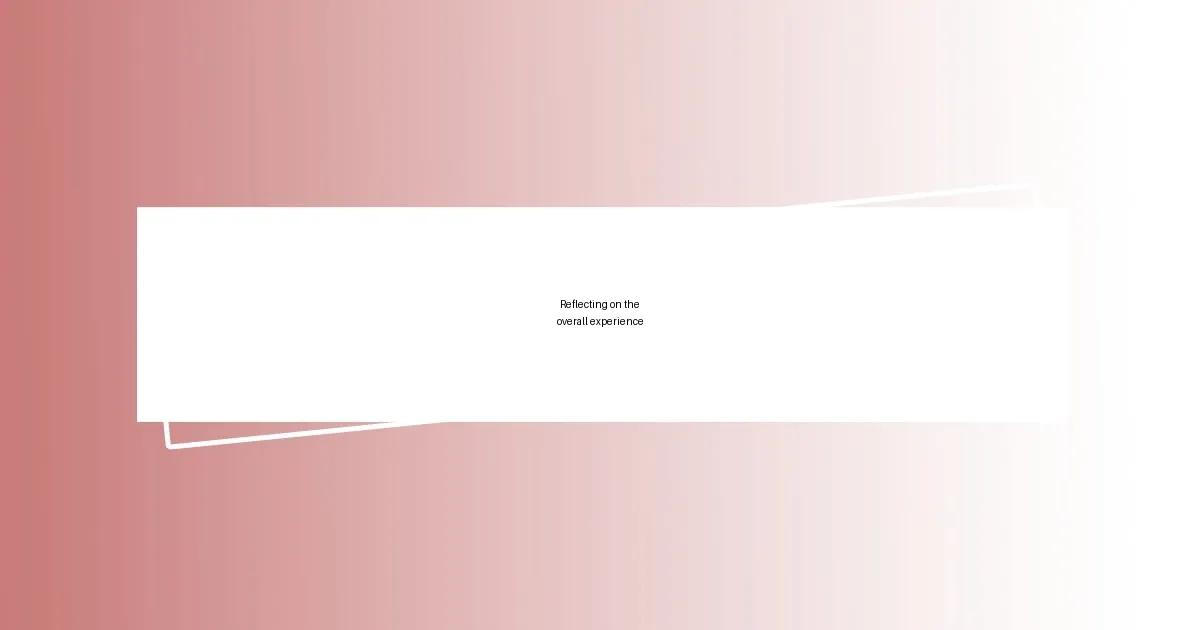Key takeaways:
- Choosing the right conference is crucial; focus on topics, speaker relevance, and interactivity to enhance your experience.
- Prepare adequately by reviewing the agenda, testing technology, and creating a comfortable workspace to maximize engagement.
- Active participation during sessions, utilizing chat features, and networking during breaks can foster valuable connections and collaborations.
- Follow up with contacts made and reflect on insights gained to nurture relationships and apply new ideas effectively in your work.

Choosing the right virtual conference
Choosing the right virtual conference can feel overwhelming, especially with so many options available. I remember standing in front of my laptop, scrolling through event flyers, and asking myself: “What truly matters to me?” For me, it was essential to find a conference that aligned with my professional goals and featured speakers whose work I admired.
Consider the topics presented at each conference. When I stumbled upon a virtual event that focused specifically on a niche I was passionate about, excitement surged through me. I realized that immersing myself in relevant discussions not only expanded my knowledge but also connected me with like-minded individuals who shared my interests. Isn’t it thrilling to think that the right conference could spark new ideas or partnerships?
Don’t forget to check the interactivity of the event. I attended a conference where the organizers encouraged active participation through polls and Q&A sessions, which made me feel engaged and valued. Engaging with fellow attendees and presenters can turn a passive learning experience into a vibrant exchange of ideas, which is something I find incredibly rewarding. So, how does the virtual platform make you feel? That gut feeling can often guide you to the right choice.

Preparing for the virtual event
Preparing for a virtual event can take some intentional steps, and I’ve learned that the right preparation can enhance the experience dramatically. Before attending, I always set aside time to familiarize myself with the conference schedule. During one event, I nearly missed a session that excited me—it was buried under a host of others. So, I recommend blocking out specific times on your calendar to ensure you don’t overlook important discussions.
Here’s a checklist that I find helpful in preparing for any virtual conference:
- Review the agenda: Identify key sessions and speakers you want to hear.
- Test your technology: Ensure your computer, internet connection, and any software are functioning smoothly.
- Prepare questions: Jot down any specific queries you want to bring up during Q&A sessions.
- Engage with others: Reach out to fellow attendees before the event, possibly through social media, to find conversation partners during the conference.
- Create a comfortable workspace: Set up a distraction-free area with good lighting and all your materials at hand, making it feel as inviting as possible.
By taking these steps, I’ve noticed I feel more prepared and able to dive headfirst into the discussions. It transforms the experience from merely attending to genuinely participating.

Engaging effectively during sessions
Engagement during virtual sessions often hinges on how actively I choose to participate. For example, during one particularly involved panel discussion, I found myself asking a burning question that had been lingering in my mind. The presenter responded enthusiastically, and suddenly, I felt a direct connection not only with them but also with fellow attendees who chimed in. That moment reinforced how simple engagement can ignite a deeper conversation. Have you ever experienced that rush when you contribute to a dialogue? It’s electrifying!
Utilizing chat features has been another game-changer for me. While attending a workshop, I discovered that by sharing thoughts and resources as the speaker talked, I became part of a vibrant discussion with my peers. Instead of just passively absorbing information, I actively created a kind of collective knowledge with others. You really can turn a one-way presentation into a back-and-forth exchange that feels more like a community gathering. It left me energized and with new insights to ponder once the session ended.
Lastly, I cannot stress enough the value of virtual networking during breaks. I recall moments when mingling in breakout rooms led to unexpected collaborations. Instead of scrolling through social media, I’d engage with fellow attendees, sharing ideas and even personal experiences. That human connection created a warm atmosphere, making the virtual conference feel less lonely. What about connections you’ve made during your own events? They often turn out to be the most rewarding aspect of the experience.
| Engagement Strategy | Description |
|---|---|
| Active Participation | Asking questions or sharing insights during presentations to foster connection. |
| Utilizing Chat Features | Engaging in real-time discussions and sharing resources while presentations occur. |
| Networking During Breaks | Connecting with attendees during breaks to develop relationships and collaborations. |

Leveraging networking opportunities
I often find that the magic of virtual conferences lies in the networking opportunities presented alongside the sessions. One time, I signed up for a speed networking event scheduled during a lunch break. At first, I was hesitant, unsure if such a format could foster meaningful connections. However, when I ended up paired with a participant from across the globe, I discovered we shared similar interests and projects. We exchanged ideas and resources that have significantly impacted my work. Have you ever experienced a chance encounter that led you down a new path? It’s moments like those that remind me of the importance of seizing networking opportunities.
Another strategy I’ve employed is participating in social media groups related to the conference. During one event, I joined a dedicated Facebook group where attendees were not just sharing speaker highlights but engaging in deeper discussions about their takeaways. This online community extended past the event, allowing me to stay connected with like-minded individuals. I even found a potential collaborator for a future project through a casual comment I made about a session. Isn’t it incredible how a simple tweet or post can evolve into something impactful?
Lastly, I suggest taking full advantage of follow-up opportunities. After a recent virtual conference, I made it a point to reach out to the people I met via LinkedIn. I sent personalized messages reflecting on our conversations, expressing where I’d like to keep the dialogue going. This effort resulted in several meaningful connections, culminating in two fruitful collaborations. How do you approach maintaining relationships after a conference? I’ve learned that a little follow-up can go a long way in expanding your professional network.

Following up after the conference
After the conference, one of my first actions is to sift through my notes and the contacts I’ve made. As I review them, I remember a fascinating conversation I had with a speaker about the innovations in my field. It’s amazing how a single discussion can spark new ideas! This motivates me to send a quick email or LinkedIn message to that speaker, mentioning our exchange and asking for further insights. I find that this kind of follow-up often leads to a deeper connection and sometimes even future collaborations.
I also like to take a moment to reflect on my overall experience and the lessons learned. For instance, after one conference, I created a short blog post summarizing my key takeaways. This not only reinforces the information for me but invites others to engage with my insights. I often wonder if others do this too—maybe they share their thoughts online or in professional networks. It’s invigorating to connect with others over shared learning, and I’ve found that it opens doors to ongoing conversations long after the conference has ended.
Lastly, I make it a point to stay engaged with the conference community. I remember joining a post-conference webinar where panelists discussed the event highlights. I was surprised by how many familiar faces joined, creating a sense of community despite the virtual distance. This really underlined the idea that following up doesn’t just mean reaching out. It’s about fostering relationships that continue to grow. Have you considered how you might keep these connections alive? The potential for collaboration often lies within the conversations that follow.

Applying insights gained
One of the biggest takeaways for me after attending a virtual conference is the application of new ideas and strategies to my work. For example, during one session, a speaker shared a unique approach to project management that resonated with me. I implemented their technique in my next project—and wow, the results were remarkable! I can’t help but wonder, have you ever encountered a concept that completely shifted how you operate?
Reflecting on insights gained is also crucial for meaningful application. After a recent conference, I spent time brainstorming how to translate the session discussions into actionable steps. I drew a mind map, connecting various insights to my current projects. This clarity not only helped me prioritize tasks but also reinvigorated my passion for my work. Have you ever felt a renewed sense of motivation after piecing together what you learned at an event?
Lastly, I find that sharing the insights is just as important as applying them. I remember hosting a small virtual roundtable with colleagues to discuss key takeaways. The energy in that discussion was infectious! Each person brought their perspective, enriching our collective understanding. This experience made me realize that collaboration often stems from a simple sharing of ideas. How do you bring your conference insights back to your team or network? I believe that the more we share, the more we grow together.

Reflecting on the overall experience
Reflecting on my overall experience at the virtual conference felt like unearthing a treasure trove of insights. During one session, I was struck by a speaker who shared their journey of overcoming challenges in our field. It made me think deeply about my own obstacles and how they shape my professional identity. Have you ever found inspiration in the struggles of others? I took away not just practical tips, but a renewed sense of resilience.
The rich tapestry of perspectives from fellow attendees also left a significant impact on me. Participating in breakout sessions, I remember discussing a hot topic with individuals from various backgrounds. Their unique viewpoints broadened my understanding and prompted me to consider solutions I hadn’t thought of before. It was a reminder that community and collaboration—even in a virtual setting—can fuel innovation and creativity. Have you ever experienced that “aha!” moment when someone else’s insights shift your thinking?
Ultimately, I realized that the virtual format added an unexpected layer of accessibility. I felt more comfortable sharing my thoughts and questions without the usual in-person anxieties. This fostered an environment where dialogue flowed freely, enhancing my overall experience. As I reflect on this, I wonder—how do such interactions influence your learning? For me, it solidifies the importance of not just attending these events, but engaging fully with every opportunity they present.














